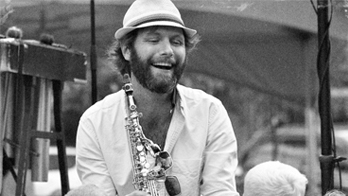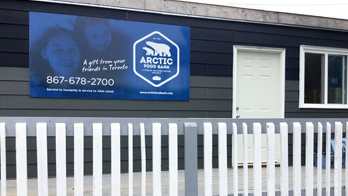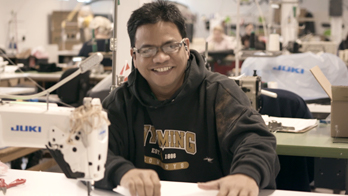Mistaking Baffin Island for Banff brought a qualified nurse to promote continuity of care in Canada’s northern communities.
#ImmigrationMatters in Iqaluit, Nunavut - Promoting patient care in Iqaluit
Promoting patient care in Iqaluit
May 9, 2019
Share:
Promoting patient care in Iqaluit
This video is also available in HD on YouTube. Share it on your social network or embed it into your site.
Transcript: “Immigration Matters in Iqaluit, Nunavut”
Video length: 3 minutes, 06 seconds
Fade-in of a city shot of Iqaluit showing a row of red houses.
Text displays: “Immigration Matters in Iqaluit, Nunavut”
A shot of the horizon shows mist-covered hills.
The sun shines through a green plant indoors.
Rhose, standing outside, looks into the camera.
Text displays: “Rhose Harris-Galia, Nurse Case Manager, Qikiqtani General Hospital”
Rhose: My name is Rhose Harris-Galia. I am originally from Baguio City, Philippines, and I moved to Nunavut in October of 2000. My potential employer called me and said, “Want to come up to Baffin?” I actually heard, “Banff”. She told me, “Open up a phone book, put your finger on the very end of Canada, move up until you see a little finger of land. That’s where you’re going”.
A wide shot of the city of Iqaluit.
Canadian and Nunavut flags blow in the wind.
Rhose is at her house. She hands a book to her son.
An airplane flies through the sky.
Rhose: Everything was white, no trees. A little bit of panic started setting in, but I got off the plane and realized, “You know what, I wanted an adventure, and this might just be what I needed”.
A landscape shot of a snow-covered hill.
An aerial view of the city and surrounding landscape.
A large passenger jet aircraft is parked at the airport. Stairs are connected to its rear door.
Rhose walks in the hospital parking lot during sunset. She looks out into the distance.
Rhose: I’m a registered nurse here at the Qikiqtani Hospital in Iqaluit. As a nurse case manager, we help organize appointments and make sure that any patient information is transferred over to their physicians and to their health-care providers, so that appropriate follow up is done. Sometimes they don’t have the same nurses from point A to point B to point C, and if there are any questions in terms of follow up wherever they go down south, we are the ones that connect the dots.
The exterior facade of the Qikiqtani Hospital is shown.
Rhose picks up her office phone. Rhose sits down as she talks on the phone.
Rhose is typing on her keyboard, and looking at her computer screens.
Rhose is walking in the hallway. She is at the photocopier, copying some documents.
Rhose is walking in the hospital hallway.
Rhose is talking to hospital staff and signing some documents.
Scene fades to black.
Rhose gives Lena a hug. Lena is talking to Rhose. Lena smiles.
Text displays: “Lena Tulugak, Nurse Case Manager, Qikiqtani General Hospital”
Lena: I met Rhose in 2002 when she first started working here. She’s tried a lot of our traditional food, she wears a lot of our traditional clothes, so she’s adapted very well I think. She’s very focused. When something needs to be done, she usually does it really quick.
Rhose is eating at a dining table.
A framed painting of Inuit art is shown.
Rhose puts a hat on her son. Her other son puts on his backpack. Rhose is driving her car.
Rhose is concentrating on her computer screen.
Lena: It’s very important for patients to see the same person. To have consistency is very good. You don’t have that when people are coming and going. But when people are here for as long as Rhose has, it’s very good for the community.
Rhose is looking out of a large hospital window, pointing at the surroundings, as she talks to someone.
Lena is talking on the phone and then speaking with a colleague about some paperwork.
Lena walks out of her office with some paperwork.
The city of Iqaluit is shown through an upper-floor window.
A street-level view of a snowmobile towing a sled.
Rhose crosses a street with her son and waves to someone driving by.
The scene fades to black.
Anne: Rhose was always really enthusiastic and ready to learn everything about the community she was in. She was really interested in the world around her, the mountains. She was off hiking, and was amazed by the Northern Lights.
Text displays: “Anne Crawford, Rhose’s Former Employer”
Anne is drinking coffee and talking to Rhose.
Rhose is sitting on a couch with Anne’s dog. Rhose is cutting up food on her son’s plate.
Rhose and Anne are eating at the table.
Rhose stands on a hill at sunset. She looks back. This transitions to a close-up of her looking into the distance and smiling.
A shot of the Northern Lights dancing in the sky is shown.
Anne: I always make sure, if somebody I know has to go south for medical treatment, to try and make sure they get on Rhose’s list, because she’s the very best in terms of keeping you connected with home. She just keeps us all alive and moving.
Rhose waits by the car while her son gets out of the back seat. She walks him into a building and signs him into day camp.
Rhose closes her house door and walks to her car.
Rhose is standing on a hill. She looks at the camera and smiles.
Rhose: There’s a feeling of community. Even just walking through, you could see that people just stop on the street and just talk. You see these people living their lives, and at some point in the very minute speck of time, you were part of their lives.
A bird flies past the full moon in the sky. Rhose waves as she crosses the street. Cars drive by on the snowy road.
Series of city shots: Aqsarniit Middle School, a playground, a view from atop a hill during sunset. Rhose looks in the distance.
Rhose: I never entered the nursing field planning to make an impact. But it’s very gratifying when people say, “Thanks again for all the help you gave”, whether it was last week or it was 10 years ago. It’s a happy moment.
A series of shots go by quickly: Rhose talks with Anne over breakfast. Rhose walks up a set of stairs and down a hall. Lena pats Rhose on the back and smiles. Rhose hugs a hospital colleague and laughs with another. Rhose greets and laughs with other people from the community.
Rhose looks out into the distance. A bird flies across the horizon.
The scene fades to black.
Text displays: “Immigrants enrich our communities”
The scene fades to black.
Text displays: “Share your story #ImmigrationMatters; Facebook: @CitCanada; Twitter: @CitImmCanada; Instagram: @CitImmCanada”
The scene fades to black.
Text displays: “Canada.ca/immigration-matters”
The Immigration, Refugees and Citizenship Canada corporate signature is shown, along with the copyright message, “Her Majesty the Queen in Right of Canada, represented by Immigration, Refugees and Citizenship Canada, 2019”, followed by the Canada wordmark.
Immigration profile: Iqaluit, Nunavut
Quick facts:
- Immigrants in Iqaluit make up more than 7% of the population.
- The Philippines is the biggest source country of immigrants in Iqaluit, followed by the United Kingdom and the United States.
- Between 1980 and 2016, 56% of all immigrants to Iqaluit came as economic immigrants, while 29% were sponsored by family and 16% were refugees.
- Immigrants make up 1 out of 4 health care sector workers, including 36% of physicians, 23% of registered nurses and 37% of pharmacists.
Did you know?
- Of all the immigrants who arrive in Nunavut, 53% settle in Iqaluit.
You may also be interested in ...
 Taking Whitehorse’s music scene to new levels
Taking Whitehorse’s music scene to new levels
Olivier de Colombel was drawn to the Yukon, and now Whitehorse’s only French elementary school has a music teacher and dedicated volunteer.
 Tackling food insecurity in Canada’s North
Tackling food insecurity in Canada’s North
The Arctic Food Bank—founded by the Muslim Welfare Centre and staffed by immigrant and Indigenous volunteers—has served hundreds of Inuvik residents since 2015.
 Growing a community through immigration
Growing a community through immigration
When a close-knit community in rural Manitoba welcomes immigrants with open arms, everyone benefits – especially employers.




